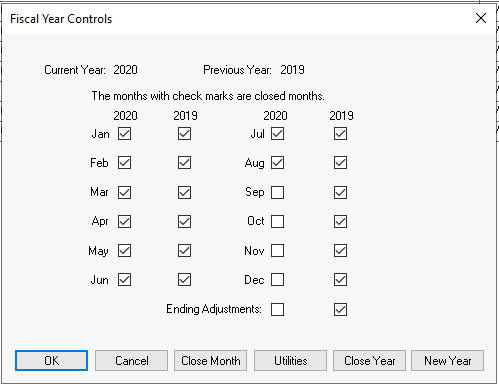
The Fiscal Year is set when the program is initially installed. Most businesses' fiscal year, with the exception of those who are incorporated, is the same as the calendar year where the first month of the year is January. If your fiscal year starts in any other month, be certain that this window reflects the proper month order of the company's year.
The proper management of the fiscal year periods is an important discipline in financial management process. Only periods that can accept transactions should be open. EBMS posts transactions based on the document date such as the invoice, journal, and payment. The user can affect the period that receives the transaction by changing the date. The financial manager can limit the range of dates required by opening and closing periods.
It is important that the year is set properly before any transactions are made since it is difficult to change. If the fiscal year needs to be changed after the system has been used, it is recommended that you contact an EBMS representative for assistance.
The fiscal year controls consist of a max of 26 open periods or 12 calendar months and 1 adjustment month for each of the two open years. The 13th month is used for year end adjustments that should not be included in the standard months. A recommended schedule:
Select

The Fiscal Year Controls always lists two sets of monthly periods. EBMS restricts any financial transactions to these 2 years. Each of the possible open monthly periods contains an month open or close check mark option.
The following tools are important steps in managing a fiscal year:
Close Month: This utility can be used to generate month end reports, run utilities, and enable the monthly close check box. This process is normally done a month or two after the last day of the given month. Review the Closing a Month section for more details and instructions on this important monthly process.
Utilities: Review [Main] Utilities > Maintenance Utility for more details on the important maintenance utilities. This process can be automated within the EBMS Server Manager. Review [Main] Server Manager > Schedule Maintenance Tasks for automation instructions.
Close Year: This utility should be launched after all months are closed for a fiscal year. Often this close year is processed at the time the tax return is completed and year end journal entries are completed. Since only two open years can be opened, last year (not current year) will need to be closed before a new year is opened. Review the Closing a Year section for more details and instructions.
New Year: The utility to create a new year within the fiscal year controls must be launched before any transactions are created for the new year. Review the Opening a New Year section for more details and instructions.
NOTE: If the recommendations listed above are properly scheduled, the user is not required to initiate any specific processes or utilities that must be completed between the last day of the fiscal year and the first day of the new year.